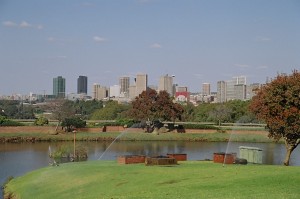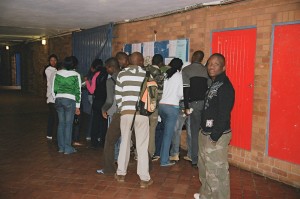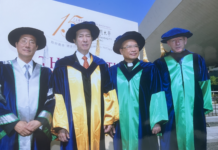White rhinos in Pilanesburg
Introduction
At the invitation of the University of Pretoria (UofP) and Tshwane University of Technology (TUT), I spent two weeks in June, 2008, in the Pretoria region of South Africa. This was a visit I had been looking forward to for many years, because I believe South Africa is pivotal in the development of sub-Saharan Africa. This became even more apparent during my stay, which co-incided with Robert Mugabe’s disturbing re-election as the president of neighbouring Zimbabwe.
Tshwane University of Technology
My first week was spent at TUT, where my host was Herman van der Merwe, and his team at the Department of Teaching and Learning with Technology. Herman has a team of instructional designers and media support staff that provide technology support to instructors across the several campuses of TUT.
In recent years, the South African government has merged a number of different institutions. TUT was formed by a merger of Technikon Pretoria, Technikon Northern Gauteng and Technikon North West, and now has approximately 50,000 students spread over nine campuses. The aim of the mergers was partly to integrate formerly separate white and black institutions, and partly to provide more efficiencies in operation. Approximately 5% of South African students go on to university, a proportion that will need to dramatically increase over the coming years.
Pretoria downtown from the TUT campus
Even so, many of the current university students are ‘first-generation’ students, the first members of their family to go to university. At TUT, potential students must come to campus to sit a supervised entrance exam. They often travel many kilometres by bus or walking to take this exam. Some students do not have enough money to take the bus home, and sleep on the campus until they get their results. At the same time, student teacher ratios are reasonably good, averaging around 30 a class.
Getting exam results at the Soshanguve campus
As well as the main campus in Pretoria, I also visited the TUT campus at Soshanguve, a predominantly black township 45 km north of Pretoria, which was a scene of riots in 2006 against poor services. TUT has made a big effort to provide access to computers and the Internet for its students, with over 400 workstations at the Soshanguve campus alone. TUT uses WebCT as its main learning management system. While at TUT I attended a one day workshop between the deans of every faculty at TUT and all the education support areas (including Teaching and Learning with Technology), where a partnership based on service contracts between the education support areas and each faculty was discussed and priorities agreed, based on the university’s strategic plan. (For more on the life of South African townships, visit the excellent Borders South Africa web site. Thanks to The PerfectMomentProject for this link.)
While in Pretoria, I also took the opportunity to pay a very short visit to the University of South Africa (UNISA). This is the oldest open university in the world, with currently 250,000 distance education students, and offers a diverse choice of study fields at levels from certificate to degree. Recently it was merged with Teknikon SA, another large distance teaching university focusing on vocational and technical education. My host there was Deon van der Merwe, Director of the Department of Information and Communication Technology, and his colleague, Johann Moller.
Although still predominantly a print-based distance teaching university, UNISA is gradually adding online components to its courses, on an optional basis. Currently, less than 5% of people in South Africa have Internet access, so I was surprised and impressed that over 160,000 of UNISA’s students now have an online account with UNISA, especially since UNISA tends to attract the least wealthy of all South African university students. One reason for this high rate of access is that many of the students have access to the Internet through Internet cafés or at work. MyUNISA is its portal for student services, and SAKAI is its learning management system.
University of Pretoria
My last visit was to the University of Pretoria (UP), where my host was Johan Freysen, the Acting Director of the Department of Education Innovation, which was hosting a conference to celebrate the 100th anniversary of the founding of the university. I was a keynote speaker at the conference, together with Diana Laurillard, a former close colleague of mine at the British Open University in the 1980s. The University of Pretoria has approximately 35,000 students, and since apartheid has moved from a ratio of 40% black students to currently around 60%.
The Department of Education Innovation has over 80 staff, providing technical support to instructors throughout the university and its several campuses. As with many other universities, there was a frustration within the department that not enough academic staff were fully utilising new technologies for teaching, although there was strong moral support from the senior management. Blackboard is the learning management system. UP has a separate Unit for Distance Education which serves 16 000 teachers in rural areas with teacher development programmes (although these programmes are primarily paper-based.)
One impressive feature of UP was its client services centre. UP has implemented a one-stop service by which students can access the full range of students services, from counselling to registration to financial services, through telephone, Internet or face-to-face contact.
Conclusions
Neither TUT nor UP were much engaged with distance education (except for the in-service teacher training program at UP), mainly because of government policy giving priority to UNISA for distance education programs. This I saw as an overly restricted limitation, since it will become important for South African lifelong learners/graduates to have access to courses or programs that draw on the research and expertise being developed in the research universities, especially since UNISA’s main focus is on first-time degree students.
South Africa is by far and away the most economically developed country in sub-Saharan Africa, and it is also a continental leader in both e-learning and distance education The universities I visited had excellent technology support staff, with a good understanding of new developments such as Web 2.0. Computer and Internet access on campus was generally good, although student queueing was sometimes a problem. Although computer and Internet access was more restricted and much more expensive off-campus, I was still surprised at the relatively high proportion of students who are now using off-campus access to supplement their on-campus use.
Indeed, the main challenge for South African universities seems to be the same as everywhere else: underuse of technology by faculty, quality issues due to a lack of training, and lack of innovative uses of technology by those who are using it for teaching. Underlying all this is the need to expand very rapidly the South African higher education system without losing quality, a formidable challenge for a country where poverty is still strongly evident.
In general, though, I left very encouraged and impressed with what colleagues are doing in South Africa, although that judgement may be slightly influenced by the wonderful hospitality I received from Herman and Johan and their colleagues.
One of many giraffes in Pilanesburg













 Dr. Tony Bates is the author of eleven books in the field of online learning and distance education. He has provided consulting services specializing in training in the planning and management of online learning and distance education, working with over 40 organizations in 25 countries. Tony is a Research Associate with Contact North | Contact Nord, Ontario’s Distance Education & Training Network.
Dr. Tony Bates is the author of eleven books in the field of online learning and distance education. He has provided consulting services specializing in training in the planning and management of online learning and distance education, working with over 40 organizations in 25 countries. Tony is a Research Associate with Contact North | Contact Nord, Ontario’s Distance Education & Training Network.


Great photos Tony. Congratulations on your new web site. Keep those updates on your travels coming, great to hear about what’s going on it other countries, and see those pictures.
r
Cool!
Great description of the South African seen. Well captured. I was at the e-Learning Indaba “ 2011 Feb Conference” organised by the Public Administration Leadership and Management Academy (Palama) where Deon van der Merwe (UNISA), Prof Johannes Cronje (Cape Peninsula University of Technology), Mr H Stafford IBM South Africa spoke at large of the South African e-Learning industry both in academia and Corporate training and development.